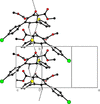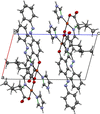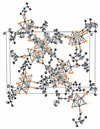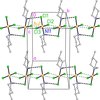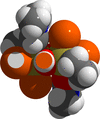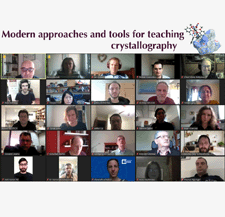issue contents
May 2024 issue
Early view articles

research communications
Download citation


Download citation


In the structure of the title co-crystal, C3H3N3O2·C5H8N2, the components are linked by a set of directional O—H⋯N, N—H⋯O, N—H⋯N and C—H⋯O hydrogen bonds to yield a two-dimensional mono-periodic arrangement. The structure propagates in the third dimension by extensive π–π stacking interactions of nearly parallel molecules of the two components, following an alternating sequence. The primary structure-defining interaction is very strong oxime-OH donor to pyrazole-N acceptor hydrogen bond [O⋯N = 2.587 (2) Å], while the significance of weaker hydrogen bonds and π–π stacking interactions is comparable.
CCDC reference: 2343837
Download citation


Download citation


In the title compound, molecules are connected by intermolecular C—H⋯S hydrogen bonds with ![[R_{2}^{2}]](/e/issues/2024/05/00/nx2007/teximages/nx2007fi1.svg) (10) ring motifs, forming ribbons along the b-axis direction. C—H⋯π interactions consolidate the ribbon structure while van der Waals forces between the ribbons ensure the cohesion of the crystal structure.
(10) ring motifs, forming ribbons along the b-axis direction. C—H⋯π interactions consolidate the ribbon structure while van der Waals forces between the ribbons ensure the cohesion of the crystal structure.
CCDC reference: 2344995
Download citation


Download citation


The synthesis, crystal structure and Hirshfeld analysis of cis-jasmone 4-ethylthiosemicarbazone are reported. The crystallographically independent molecule shows disorder over the jasmone carbon chain and, in the crystal, the molecules are linked by H⋯S and H⋯N interactions into mono-periodic hydrogen-bonded ribbons parallel to the b-axis.
CCDC reference: 2304271
Download citation


Download citation


δ-Valerolactone was reacted with hydrazine hydrate in methanol affording crystals of 5-hydroxypentanehydrazide, which were characterized via single-crystal X-ray diffraction. The compound crystallizes in the orthorhombic space group Pca21 without any crystallization solvent. The hydrazide functional group shows C—N and C=O bond lengths measuring 1.3376 (17) Å and 1.2375 (16) Å, respectively.
CCDC reference: 2345070
Download citation


Download citation


In the crystal structure of the title compound, discrete complexes with a rare Co coordination are found, in which the CoII cations are fivefold coordinated by two thiocyanate anions and three 4-methylpyridine N-oxide coligands within a slightly distorted trigonal–bipyramidal coordination.
CCDC reference: 2347581
Download citation


Download citation


The crystal structure is reported of the copper(II) complex with an amino acid Schiff base ligand synthesized from azobenzene-salicylaldehyde, L-leucine and copper(II) acetate. The crystal structure features N—H⋯O hydrogen bonds.
CCDC reference: 2347500
Download citation


Download citation


The structure of [Mo3S7(S2CNiBu2)3]2(μ6-S) features a μ6S22− anion asymmetrically wedged between two [Mo3S7(S2CNiBu2)3]+ cations with close μ6-S2−⋯S22− contacts that indicate significant covalency to the interactions.
CCDC reference: 2345828
Download citation


Download citation


All three structures involve chains of molecules linked by Au⋯halogen contacts; these are accompanied by hydrogen bonds or halogen⋯halogen contacts.
Download citation


Download citation


Reaction of Co(NCS)2 with 4-methylpyridine N-oxide in methanol leads to the formation of Co2(NCS)4(4-methylpyridine N-oxide)4(methanol)2, in which the CoII cations are linked by pairs of μ-1,1-bridging 4-methylpyridine N-oxide coligands into centrosymmetric dinuclear units.
CCDC reference: 2347590
Download citation


Download citation


A novel five-coordinate CoII complex based on two neutral ligands {tris[(1-benzyltriazol-4-yl)methyl]amine and imidazole} demonstrating a distorted trigonal bipyramidal geometry is presented.
CCDC reference: 2348506
Download citation


Download citation


The title compound adopts an E configuration with respect to the C=N bond. In the crystal, the molecules are connected by pairs of N—H⋯S interactions, forming rings with ![[R_{2}^{2}]](/e/issues/2024/05/00/wm5713/teximages/wm5713fi1.svg) (8) graph-set motifs, and by pairs of C—H⋯S interactions, where rings with graph-set motif
(8) graph-set motifs, and by pairs of C—H⋯S interactions, where rings with graph-set motif ![[R_{2}^{1}]](/e/issues/2024/05/00/wm5713/teximages/wm5713fi2.svg) (7) are observed.
(7) are observed.
CCDC reference: 1909895
Download citation


Download citation


In the crystal, molecules are connected by N—H⋯N and C—H⋯N, and O—H⋯N and N–H⋯O hydrogen bonds, to each other directly and through water molecules, forming layers parallel to the (001) plane. C—H⋯π interactions between these layers ensure the cohesion of the crystal structure.
CCDC reference: 2347583
Download citation


Download citation


The two independent molecules of C23H21BrN4O are closely similar and roughly planar except for the isopropyl groups. They are connected by hydrogen bonds of the types Namide—H⋯N≡C, Hphenyl⋯O=C and Hphenyl⋯Br.
CCDC reference: 2347502
Download citation


Download citation


The structures of fourteen halochalcogenylphosphonium tetrahalogenidoaurates(III) of general formula [R13-nR2nPEX][AuX4] (R1 = t-butyl; R2 = i-propyl; n = 0 to 3; E = S or Se; X = Cl or Br) are presented and compared.
Download citation


Download citation


The title compound exhibits the typical rhomboid-like four-membered Sn–OH ring found in all dimeric molecules of monoorganotin(IV)–dihalide–hydroxides, with acute bond angles at the Sn atom, obtuse bond angles at O atoms and shorter Sn—O bond lengths trans to the ethyl groups.
CCDC reference: 2348369
Download citation


Download citation


The crystal structure of the title compound consists of 2∞[Ni3As2(OH)6/3O18/3O1/1(OH)1/1] layers extending parallel to (001) and exhibits disorder of the (O/OH) units of the (hydrogen)arsenate anion; the ammonium counter-cations are sandwiched between adjacent layers.
CCDC reference: 2349363
Download citation


Download citation


The five-membered ring is slightly ruffled and dihedral angles between the pendant six-membered rings and the central, five-membered ring vary between 50.78 (4) and 86.78 (10)°. In the crystal, O—H⋯N hydrogen bonds and weak π-stacking interactions form inversion dimers, which are linked into chains extending along the c-axis direction by two sets of N—H⋯O hydrogen bonds. The chains are connected into layers parallel to the bc plane by two sets of C—H⋯π(ring) interactions.
CCDC reference: 2349453
Download citation


Download citation


In the crystal, molecules are linked by C—H⋯π interactions, forming ribbons along the a axis. Intermolecular C—H⋯O hydrogen bonds connect these ribbons to each other, forming layers parallel to the (0![[\overline{1}]](/e/issues/2024/05/00/nx2009/teximages/nx2009fi1.svg) 1) plane. The molecular packing is strengthened by van der Waals interactions between the layers.
1) plane. The molecular packing is strengthened by van der Waals interactions between the layers.
CCDC reference: 2348265
Download citation


Download citation


Two aniline-based trifluoromethylsulfonate (trifluoromethanesulfonate) salts, N,2,4,6-tetramethylanilinium trifluoromethanesulfonate and N-isopropylidene-N,2,4,6-tetramethylanilinium trifluoromethanesulfonate, were synthesized and characterized by single-crystal X-ray diffraction.

 journal menu
journal menu












